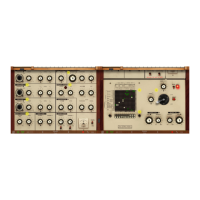If the Core MIDI Network is connected a wifi symbol will appear in the
Network port cell.
Only ports that receiving MIDI Clock will be displayed as icons,
touch the clock symbol (if present) to enable/disable receiving MIDI Clock. It
will change its color from red to blue. You can receive MIDI Clock from one
port at a time, you can enable/disable the clock for the current port or
mutually selects another one in the list.
You can receive MIDI Clock from one port at a time, you can
enable/disable the Clock for the current port or mutually selects another one
in the list.
Channel sets the input channel for the selected port, the iVCS3 DK
(Keyboard) will receive the Note On/Off messages in OMNI (from all 16
channels) or, one of the 16 channels.
Configure Bluetooth LE MIDI
With the release of iOS 8 and OS X Yosemite, sending and receiving MIDI
data is supported using Bluetooth Low Energy connections on any iOS device
or Mac that has native Bluetooth Low Energy support. All established
connections are secure which means that pairing is enforced and connections
cannot be made to your devices without your explicit consent. After a
connection is established, it simply appears as an ordinary MIDI device that
any MIDI application can communicate with.
Enable NRPN
NRPN stands for "Non-Registered Parameter Number" and is part of the MIDI
specification for the control of electronic musical instruments. NRPNs allow
for manufacturer-specific or instrument-specific MIDI controllers that are not
part of the basic MIDI standard.
Unlike other MIDI controllers (such as velocity, modulation, volume, etc.),
NRPNs require more than one piece of controller data to be sent. First,
controller 99 - NRPN Most Significant Byte (MSB) - followed by 98 - NRPN
Least Significant Byte (LSB) sent as a pair specify the parameter to be
changed. Controller 6 then sets the value of the parameter in question.
Controller 38 may optionally then be sent as a fine adjustment to the value
set by controller 6.
This fine adjustment is part of the conventional MIDI controller specification,
where any of the first 32 controls can be optionally paired with a control offset

